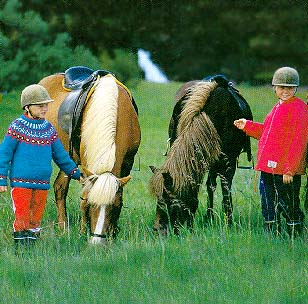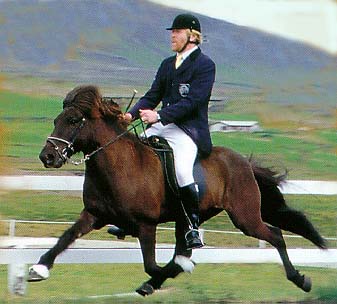

Icelandic


Introduction: If you have any comments or suggestions, please click here. I was disappointed when I found pictures of the Icelandic doing the walk, trot, gallop, and pace, but not the tølt that it is so famous for. I will keep looking, however!
Names: Icelandic, Icelandic Horse, Iceland Pony. I confess that I selected the name Icelandic because I don't want to fight over whether it's a horse or pony until I've studied up on it more! In the meantime, it's listed under Pony on the Search page because of size.
Origin: The ponies are descended from those
brought by migrating Norsemen in the 9th century, later crossed with those
accompanying settlers from the Western Isles. Until recently (written in
1974) Iceland restricted export of this little horse, but it is now a welcome
addition to the pony roster in the U.S. It originated with stock brought
to Iceland by the Norsemen around 865 A.D. and has served through the centuries
on the farms of that island country.
Believed to have lived on the island of Iceland since
Norsemen arrived in the year 874 to settle there. The horses, or ponies,
brought to Iceland by the Norsemen were probably Norwegian (Fjord?) and Irish
(Connemara), which in turn had descended from the aboriginal Celtic-type pony of
northwestern Europe. Iceland today has some 35,000 native ponies, about
half of which roam free throughout the year. The breed was introduced into
Canada in 1959 and the U.S. shortly thereafter.
Breeding: Bred from various northern European ponies. Breeding area--Iceland, bred half-wild. According to tradition, the Iceland Pony is supposed to be descended from the Norwegian Fjord Ponies which came to Iceland with the first settlers in about the year 941.
Description: There are two types, the draft and the riding pony, which possesses a distinctive, very comfortable trotting amble, known as the tølt.
Action: High knee action. Generally a walking gait.
Body: Low, powerful, well-muscled. Short neck with upstanding mane.
Color: Characteristic colors are red and chestnut, or spotted chestnut. Any color; often gray, dun, brown, black or chestnut. Mostly dun or gray. Whereas the original colors were mainly grey or dun, now it is said they are sorrel and chestnut, along with white, palomino, and black, and only an occasional dun.
Head: Large and common with Roman nose.
Hooves: Healthy and exceptionally tough.
Legs: Short and strong, with short, strong pasterns.
Size: Tall for a pony, standing at an average 13.2 hands. 12-13 hands. Between 11.2 and 14.2 hands. 48-54 inches.
Temperament: Quiet and friendly. Good-natured.
Features: Adept at finding their way home. All horses and ponies have an inbuilt homing instinct, but it is particularly strongly developed in Iceland ponies. In fact, at the conclusion of a trek many of these attractive little creatures are loosed to find their own way home, and it is very seldom indeed that a pony does not do so within the expected twenty-four hours. Hardy, sturdy, and sure-footed. Mountain pony. Very hardy and economical. Indefatigable pack animal in trackless territory.
Uses: Used as riding or pack pony. Some are bred to eat. Served on farms. Icelanders (and hardy visitors) also use them as mounts in the sport of trekking (cross-country camping).
Accomplishments: In 1965 a party set out over the 7,000 foot Panzier Pass, to ride the route taken by General Suvaroff retreating from the French during the Napoleonic Wars. Thirty years before, there were still a few Swiss descendants of the ponies of Icelandic stock, which the General had bartered for food, but the modern party rode Icelandic ponies recently re-introduced into Switzerland. Unlike Suvaroff's decimated forces, they had neither enemy fire, near starvation, nor winter weather to contend with, but snow, fog and precipitous going, to test the famed toughness of ponies that normally live at lower altitudes. All of them took the trek in their stride.
Curiosities: Horse
fighting was once a great sport in Iceland, horseflesh being the staple
diet.
Today the Icelandic ponies each year carry a growing number of
trekkers safely across the great fields of black basalt that cover most of the
island, taking them, sometimes in spectacular sunsets, to view natural wonders
such as towering, glinting glaciers, boiling springs, and spouting geysers and
fissures.
In most countries, pacers are raced in front of a
sulky, but in Iceland, the rider is mounted on the
horse. This type of racing is one of the oldest and most
popular equestrian sports in Iceland!
Profiles:
Conclusion: